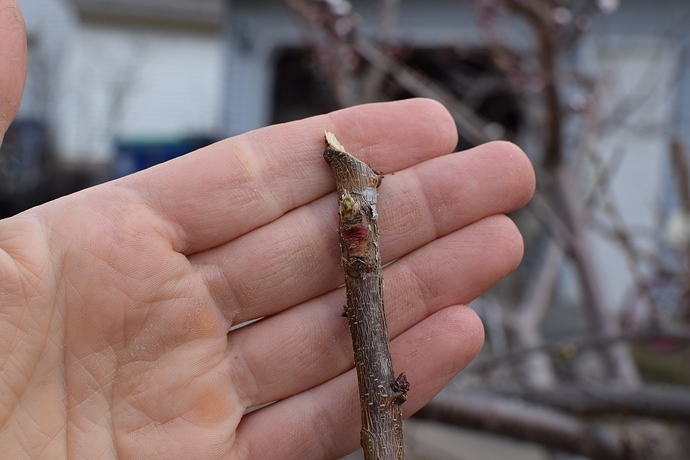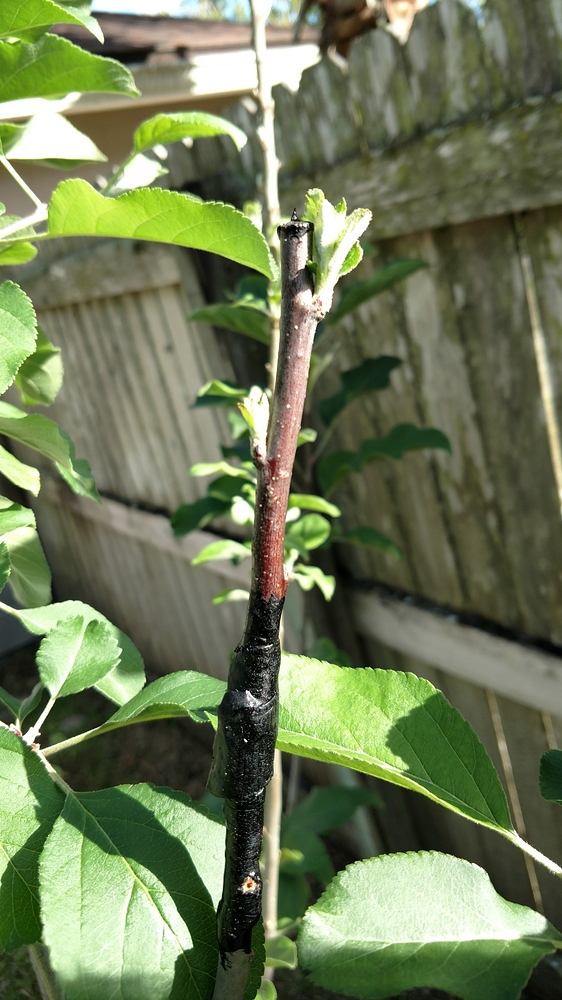I call BS because I’ve successfully cleft grafted dozens of scions successfully and I try to push mine in until the cut is even with the rootstock. I’m not saying that method doesn’t work or isn’t better but I can assure you that grafts can successfully be down without the exposed wood.
Yesterday, I finished my first pass of all my grafts, including the plums, apricots, and peaches.
In the past, I’ve had poor success rates with stonefruit grafts. I’m hoping for better this year.
Even plum? Last year I had bad luck with peaches but I had higher rates with plums that I even did with apples.
I’ve had only a few plums or plumcots take over the years, and many of those declined and died.
My only successful long-lasting plum graft is a Mirabelle de Nancy on Coe’s Golden Drop/ Marianna.
I didn’t look at the video but I think what he means is don’t push it in all the way - the cambium spot curves at the top there. also its fatter at the top and you may lose tight contact on the lower part if you push it in too far. So, depending on how you do the cuts this “rule” may or may not apply. The “real” rule is make sure you have lots of cambium to cambium contact.
I agree 100%. Plums are among the easiest for me, peaches most definately the worst, apples and pears a very close 2ed to plums.
I also agree about leaving that little nick. Not sure what it even is exactly, but I always put rootstock flush with scion and cover it all and have pretty darn good success rates on plums, pears, and apples. That guy is wrong-and its not often I feel confident enough to say another fruit person is wrong!
Agreeing with Scott that the exposed cambium curves because of the way the scion is cut whilst the exposed cambium on the rootstock is straight. I don’t think that means the graft will fail necessarily but that your cambium contact at the top of the rootstock is not as good if the curved part is pushed down all the way.
Scott-
I budded a nectarine to Spring Satin. Any hopes it makes it? Looks like its going to push (if it would warm up). I made the mistake of budding some other peaches directly to apricot (puget gold)…thinking that was a mistake (i had a Saturn runt out and die in the past).
I’m a little confused but I think what you guys are talking about is when you hand cut your scion- right where the cut begins as you curve it toward the end to bring it to a point. I do most of mine with an omega grafting tool so it doesn’t have those curved cuts- it just makes a female end on one and a male end on the other. The shape of those 2 depend on which die is used on the tool, but when you fit them together the stems sit flush against each other except where the fit “into” each other. I’m doing a terrible job describing this, but the point it I think you’ve helped me understand “the curve” but with an omega tool there really isn’t that curve. The reason I like the tool is that I am so bad at hand cutting scions to fit together…I often scoop out a little divot between the start of the cut and the end/tip, which makes a lot more space without cambium contact.
I don’t know if leaving that exposed bit makes the graft better. It’s quite possible that it may. I’m just saying his statement of “the graft will not take” is not true. I push the Scion in until the two cuts meet. In my mind I’ve done this because it keeps the wood on the Scion from being exposed. Even though I use parafilm I feel like leaving them flush with each other would reduce desication in the Scion.
Me too. I know this comes with practice BUT when I heard Tom Spellman on one of the DWN videos on grafting say, “Don’t whittle”…well let me just admit to my friends that I’m a closet whittler. One flat cut doesn’t suit me…and I’ve become a pretty good whittler in the process. And nature has smiled on my grafts. 
Agreed. That was my interpretation as well.
Thanks for the pics, all! As a first-time grafter waiting to see if any of my grafts have taken, I can see right offhand that I probably used too much parafilm around the scion. Perhaps I can gingerly remove a layer or so of the wrap. We’ll see if I get any bud breaks in the next couple of weeks.
It is best in my opinion to stretch the parafilm before putting it on but you might do more harm than good trying to remove it. Buds will amaze you as to what they can push through.
Oh, I don’t think you need to, and you’ll probably find that parafilm doesn’t necessarily unwrap as easily as it wraps! I say leave the graft alone- I’ll bet that the buds, if the grafts are well done and I’ll bet they are, will push through. And there is a big risk of damage if you start wiggling things around.
Plants may be slow, but they are persistent- just look and see how often dandelions manage to find their way through asphalt.
It looks pretty happy now. Thats not supposed to be a great match but I don’t think its tried very often so it may not work out so badly. I almost tried a similar one last weekend, I have more apricot stocks than apricot scions and too many peach scions for the stocks I have.
Here is a photo of the first grafts of the year of a project I have going of grafting everything I buy and find to some of the ‘wild’ apple trees. Even though this one will be in the creek in a few years it could still make some ‘security’ scions. On the left are two whip grafts, and on the right are two cleft grafts, and some beaver skin moccasins and a hat.
I have many more grafts on this tree, way up high out of beaver, bunny, and deer range.



